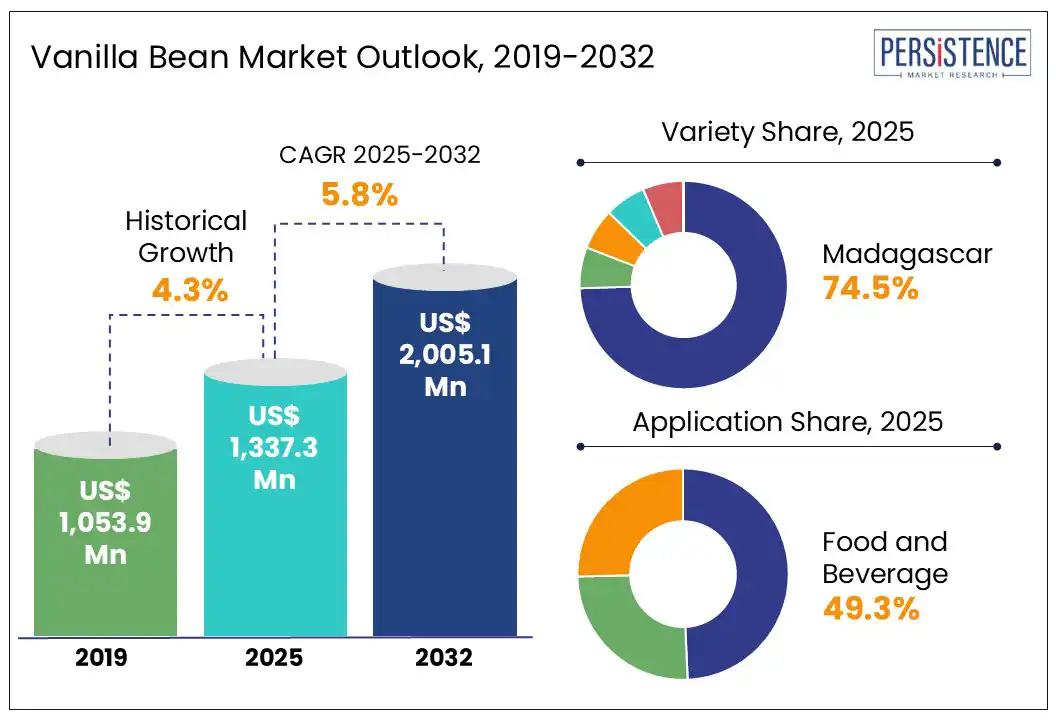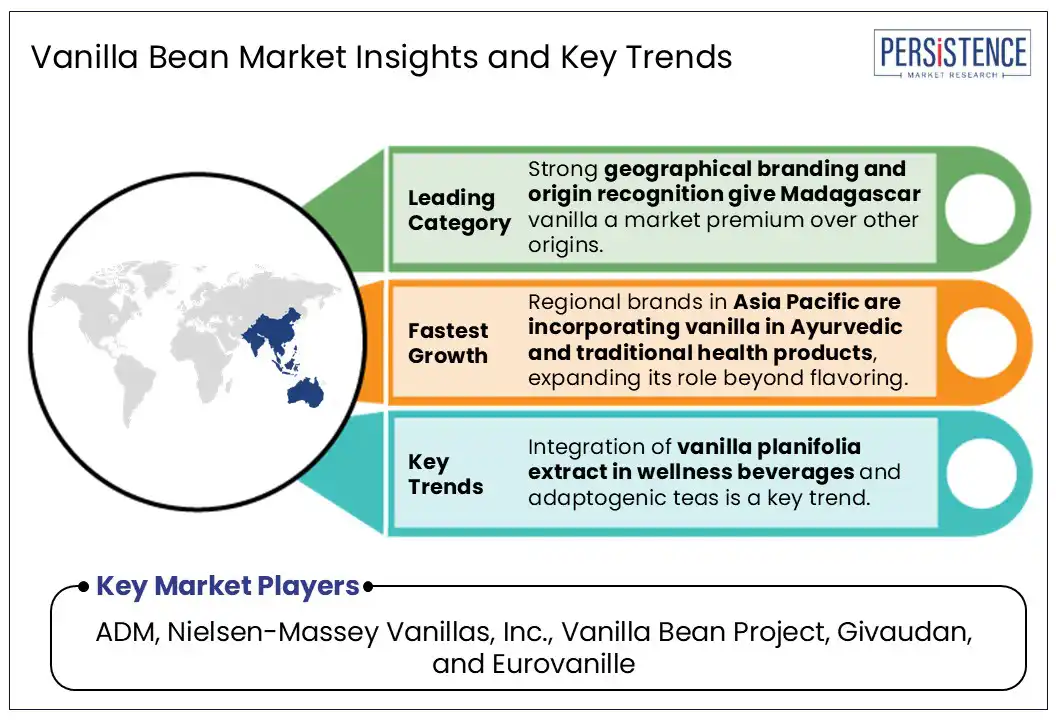ID: PMRREP21652| 175 Pages | 7 Aug 2025 | Format: PDF, Excel, PPT* | Food and Beverages

The global vanilla bean market size is projected to rise from US$ 1,337.3 Mn in 2025 to US$ 2,005.1 Mn by 2032. It is anticipated to witness a CAGR of 5.8% during the forecast period from 2025 to 2032. Vanilla beans, once prized as the sacred flavor of the Aztecs, have evolved into one of the most coveted and complex agricultural commodities in the global market. Vanilla beans are at the heart of a volatile yet broad supply chain that stretches from the rainforests of Madagascar to boutique perfumeries in Paris and wellness labs in Tokyo. With the rising demand for natural ingredients in food, beverages, pharmaceuticals, and cosmetics, vanilla beans are experiencing an increasing adoption.

Key Industry Highlights:
|
Global Market Attribute |
Key Insights |
|
Vanilla Bean Market Size (2025E) |
US$ 1,337.3 Mn |
|
Market Value Forecast (2032F) |
US$ 2,005.1 Mn |
|
Projected Growth (CAGR 2025 to 2032) |
5.8% |
|
Historical Market Growth (CAGR 2019 to 2024) |
4.3% |
Surging demand for premium ice cream and clean-label skincare products is significantly pushing the vanilla bean market growth. In the premium ice cream segment, vanilla remains the most popular standalone flavor, and also a foundational note in complex creations. Brands such as Jeni’s Splendid Ice Creams, Van Leeuwen, and Häagen-Dazs are emphasizing the use of real vanilla beans over synthetic vanillin, promoting authenticity and origin transparency.
On the skincare front, vanilla bean extracts are gaining popularity not just for their fragranc but for their antioxidant and anti-inflammatory properties. Brands such as Lush have recently introduced skincare products featuring vanilla planifolia fruit extract as a functional ingredient and not just a scent. These formulations often claim to soothe the skin, calm irritation, and even help reduce oxidative stress, benefits typically targeted toward aging or sensitive skin.
Ethical and environmental criticisms have become significant impediments to the long-term sustainability of the vanilla market, mainly for natural vanilla sourced from Madagascar. A key issue is the persistent unfair pricing and income volatility faced by farmers. During price surges, vanilla farmers received minimal profits due to middlemen and a lack of direct market access. Conversely, when prices dropped sharply between 2022 and 2023, several smallholder farmers were left financially devastated. This boom-and-bust cycle discourages long-term investments in quality and traceability, leading to premature harvesting.
Environmental degradation tied to vanilla farming has also drawn increasing scrutiny. In Madagascar’s Sava district, vanilla-driven deforestation is accelerating as farmers clear protected or ecologically sensitive areas to extend cultivation. Such practices not only threaten biodiversity but also risk regulatory backlash from international buyers and NGOs. The reputational damage is particularly severe for luxury food and fragrance brands, which are increasingly held accountable for the ethics of their sourcing.
The booming pharmaceutical industry is creating new opportunities for vanilla beans by increasingly integrating natural compounds such as vanillin into therapeutic and functional formulations. Vanillin has demonstrated antioxidant, anti-inflammatory, neuroprotective, and antimicrobial properties in recent pharmacological studies. These bioactivities are being explored not just in alternative medicine but also in mainstream drug formulations as demand surges for plant-based, bioactive ingredients that meet the clean-label excipient requirements.
A 2023 study published in Frontiers in Pharmacology, for instance, highlighted vanillin's potential in neurodegenerative disorder management by modulating oxidative stress and inflammation in neuronal pathways. Pharmaceutical excipients derived from natural vanilla are also gaining traction as flavor-masking agents in oral syrups, chewable tablets, and pediatric formulations. Vanilla’s mild, sweet profile helps improve the palatability of bitter Active Pharmaceutical Ingredients (APIs), making it a preferred natural additive in pediatric and geriatric medicines. Leading pharma ingredient suppliers have been exploring plant-derived flavor carriers, including pure vanilla extract, for use in functional health products.
Based on variety, the market is divided into Madagascar, Tahitian, Mexican, and Indonesian. Among these, Madagascar is expected to account for approximately 74.5% of the market share in 2025 due to the complex and rich flavor profile of Madagascar vanilla beans. These are characterized by creamy, sweet, and warm notes with a distinctive depth that other origins often lack. This flavor intensity is mainly a result of the unique terroir of Madagascar’s Sava region, where the blend of volcanic soil, humidity, and consistent rainfall creates ideal growing conditions for vanilla orchids. The beans from this region typically have a higher vanillin content, often surpassing 2%, which enhances their aromatic potency in culinary and perfumery applications.
Mexican vanilla bean variety is gaining impetus due to its distinctive flavor profile that differs significantly from the dominant Madagascar Bourbon variety. Mexican beans are known for their bold, creamy notes with a deep, spicy undertone and hints of smoke. These characteristics make them appealing for gourmet applications and high-end artisanal products. This complexity stems from the country’s unique pollination environment and soil characteristics, as well as the presence of the native Melipona bee. It enables natural pollination, which is often not found in other growing regions where hand-pollination is the norm.
By application, the market is trifurcated into cosmetics and personal care, pharmaceuticals, and food and beverage. Out of these, the food and beverage segment will likely hold around 49.3% of the vanilla bean market share in 2025, with the compound’s wide-ranging flavor compatibility, primarily with dairy, chocolate, and baked goods, which dominate consumer palates globally. Vanillin, the primary aromatic compound in vanilla beans, enhances not only sweetness but also rounds out bitter or acidic notes. This makes it a key flavor enhancer across categories such as ice cream, yogurt, confections, cakes, and carbonated beverages. In addition, the clean-label movement has surged demand for natural flavorings, compelling manufacturers to replace synthetic vanillin with real vanilla bean extracts.
Cosmetics and personal care have emerged as a key application area owing to the increasing preference for botanical and natural ingredients in skincare and fragrance formulations. Vanilla bean extracts are extensively used in anti-aging and skin-soothing products for their ability to neutralize free radicals and reduce inflammation. This caters to the global clean beauty movement, where consumers actively seek products that are both effective and derived from recognizable sources. In the fragrance segment, vanilla remains one of the most sought-after base notes due to its warm, comforting aroma and strong fixative properties.

In 2025, Asia Pacific is estimated to account for nearly 55.2% of the global market share as it is gaining momentum both as an expanding production zone and a rapidly growing consumer base. Indonesia and Papua New Guinea have emerged as significant producers. What differentiates Indonesia is its focus on the Indonesian Planifolia variety, which has a slightly smoky and woody profile due to its unique curing process. This flavor profile is increasingly accepted in industrial applications such as flavored beverages and processed foods, owing to cost competitiveness.
Papua New Guinea is also climbing the ranks as a vanilla supplier, mainly among buyers in Europe. The country is known for both Planifolia and Tahitensis varieties. At the same time, it benefits from EU-backed capacity-building programs that focus on sustainable farming, quality control, and fair-trade certifications. As per a recent study, from 2022 to 2023, the country exported over 110 metric tons of vanilla, with a significant portion going to France and Germany. This is noteworthy as it suggests a shift toward diversified sourcing among buyers who previously relied heavily on Madagascar.
North America plays a dual role in the market, i.e., as a significant consumer and an emerging cultivator. The U.S. vanilla bean market is predicted to remain at the forefront due to the compound’s extensive use in the bakery, dairy, confectionery, and beverage sectors. Surging trend of clean-label and natural flavoring in packaged food has boosted the shift from synthetic vanillin to natural vanilla bean extracts. Companies such as Nestlé USA and General Mills have reformulated product lines over the past few years to remove artificial flavors. It has contributed to the rising demand for traceable and sustainably sourced vanilla beans.
There is also a small but growing vanilla cultivation effort across North America, primarily in Hawaii, Florida, and Puerto Rico. Hawaii has emerged as the most promising site, with start-ups investing in controlled-environment agriculture and agrotourism to capitalize on the premium market. These beans are usually marketed as luxury ingredients due to their limited supply and unique terroir. Although domestic production is minimal, it reflects a rising interest in shortening supply chains and reducing dependency on volatile overseas markets such as Madagascar.
The Middle East & Africa presents a contrasting but interconnected scenario in the market. Africa, particularly Madagascar, remains the global powerhouse, accounting for around 80% of the world’s natural vanilla production. The country’s Sava region is the epicenter of this activity. While it continues to dominate, its position is challenged by persistent issues such as price volatility, premature harvesting, and weather-related disruptions. The 2023 vanilla season in Madagascar saw improved quality controls and government intervention to stabilize pricing at around US$ 250 to 300 per kilogram, down from peak of US$ 600 in 2018.
Other countries such as Uganda and Comoros are capitalizing on Madagascar’s volatility by positioning themselves as stable, ethical, and high-quality alternatives. Uganda has been gaining momentum due to its biannual harvests, relatively stable climate, and support from international buyers. The Middle East is not a production center but is evolving into a surging consumer of premium vanilla products, supported by the rise of artisanal food and luxury fragrance markets. The UAE and Saudi Arabia have seen a boom in gourmet patisseries, boutique bakeries, and niche perfume houses, all of which heavily rely on natural vanilla.
The global vanilla bean market is characterized by a balance between limited global production and rising demand across industries such as cosmetics and food & beverage. The market is witnessing a shift toward traceability and ethical sourcing, with key buyers investing directly in sustainable farming initiatives. Leading players are forging long-term contracts with farmers and cooperatives to ensure quality, transparency, and steady supply to bypass volatile spot markets. In addition, biotech firms are gaining traction by offering synthetic vanillin through fermentation processes. This strategy is enabling them to position themselves as cost-effective and sustainable alternatives amid fluctuating natural vanilla prices.
The vanilla bean market is projected to reach US$ 1,337.3 Mn in 2025.
High demand for premium ice cream and surging preference for natural flavor enhancers in infant nutrition are the key market drivers.
The vanilla bean market is poised to witness a CAGR of 5.8% from 2025 to 2032.
The emergence of origin storytelling and the shift from bulk vanilla to single-origin beans are the key market opportunities.
ADM, Nielsen-Massey Vanillas, Inc., and Vanilla Bean Project are a few key market players.
|
Report Attribute |
Details |
|
Historical Data/Actuals |
2019 - 2024 |
|
Forecast Period |
2025 - 2032 |
|
Market Analysis |
Value: US$ Mn |
|
Geographical Coverage |
|
|
Segmental Coverage |
|
|
Competitive Analysis |
|
|
Report Highlights |
|
|
Customization and Pricing |
Available upon request |
By Variety
By Nature
By Application
By Region
Delivery Timelines
For more information on this report and its delivery timelines please get in touch with our sales team.
About Author